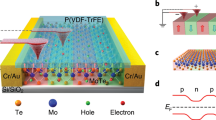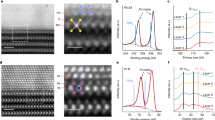Abstract
Semiconductor p–n junctions are the elementary building blocks of most electronic and optoelectronic devices. The need for their miniaturization has fuelled the rapid growth of interest in two-dimensional (2D) materials. However, the performance of a p–n junction considerably degrades as its thickness approaches a few nanometres and traditional technologies, such as doping and implantation, become invalid at the nanoscale. Here we report stable non-volatile programmable p–n junctions fabricated from the vertically stacked all-2D semiconductor/insulator/metal layers (WSe2/hexagonal boron nitride/graphene) in a semifloating gate field-effect transistor configuration. The junction exhibits a good rectifying behaviour with a rectification ratio of 104 and photovoltaic properties with a power conversion efficiency up to 4.1% under a 6.8 nW light. Based on the non-volatile programmable properties controlled by gate voltages, the 2D p–n junctions have been exploited for various electronic and optoelectronic applications, such as memories, photovoltaics, logic rectifiers and logic optoelectronic circuits.
This is a preview of subscription content, access via your institution
Access options
Access Nature and 54 other Nature Portfolio journals
Get Nature+, our best-value online-access subscription
$29.99 / 30 days
cancel any time
Subscribe to this journal
Receive 12 print issues and online access
$259.00 per year
only $21.58 per issue
Buy this article
- Purchase on Springer Link
- Instant access to full article PDF
Prices may be subject to local taxes which are calculated during checkout




Similar content being viewed by others
References
Novoselov, K. S. et al. Electric field effect in atomically thin carbon films. Science 306, 666–669 (2004).
Zhang, Y., Tan, Y.-W., Stormer, H. L. & Kim, P. Experimental observation of the quantum Hall effect and Berry's phase in graphene. Nature 438, 201–204 (2005).
Lin, Y.-M. et al. Wafer-scale graphene integrated circuit. Science 332, 1294–1297 (2011).
Radisavljevic, B., Radenovic, A., Brivio, J., Giacometti, V. & Kis, A. Single-layer MoS2 transistors. Nat. Nanotech. 6, 147–150 (2011).
Seyler, K. L. et al. Electrical control of second-harmonic generation in a WSe2 monolayer transistor. Nat. Nanotech. 10, 407–411 (2015).
Lemme, M. C. et al. Gate-activated photoresponse in a graphene p–n junction. Nano Lett. 11, 4134–4137 (2011).
Gong, Y. et al. Vertical and in-plane heterostructures from WS2/MoS2 monolayers. Nat. Mater. 13, 1135–1142 (2014).
Lee, C.-H. et al. Atomically thin p–n junctions with van der Waals heterointerfaces. Nat. Nanotech. 9, 676–681 (2014).
Lohmann, T., von Klitzing, K. & Smet, J. H. Four-terminal magneto-transport in graphene p–n junctions created by spatially selective doping. Nano Lett. 9, 1973–1979 (2009).
Ci, L. et al. Atomic layers of hybridized boron nitride and graphene domains. Nat. Mater. 9, 430–435 (2010).
Sun, Z. Z. et al. Towards hybrid superlattices in graphene. Nat. Commun. 2, 559 (2011).
Zhang, Z., Huang, H., Yang, X. & Zang, L. Tailoring electronic properties of graphene by π–π stacking with aromatic molecules. J. Phys. Chem. Lett. 2, 2897–2905 (2011).
Buscema, M. et al. Photocurrent generation with two-dimensional van der Waals semiconductors. Chem. Soc. Rev. 44, 3691–3718 (2015).
Huang, C. et al. Lateral heterojunctions within monolayer MoSe2–WSe2 semiconductors. Nat. Mater. 13, 1096–1101 (2014).
Deng, Y. X. et al. Black phosphorus-monolayer MoS2 van der Waals heterojunction p–n diode. ACS Nano 8, 8292–8299 (2014).
Zhang, Y. J., Oka, T., Suzuki, R., Ye, J. T. & Iwasa, Y. Electrically switchable chiral light-emitting transistor. Science 344, 725–728 (2014).
Li, L. et al. Black phosphorus field-effect transistors. Nat. Nanotech. 9, 372–377 (2014).
Baugher, B. W. H., Churchill, H. O. H., Yang, Y. & Jarillo-Herrero, P. Optoelectronic devices based on electrically tunable p–n diodes in a monolayer dichalcogenide. Nat. Nanotech. 9, 262–267 (2014).
Pospischil, A., Furchi, M. M. & Mueller, T. Solar-energy conversion and light emission in an atomic monolayer p–n diode. Nat. Nanotech. 9, 257–261 (2014).
Ross, J. S. et al. Electrically tunable excitonic light-emitting diodes based on monolayer WSe2 p–n junctions. Nat. Nanotech. 9, 268–272 (2014).
Groenendijk, D. J. et al. Photovoltaic and photothermoelectric effect in a double-gated WSe2 device. Nano Lett. 14, 5846–5852 (2014).
Buscema, M., Groenendijk, D. J., Steele, G. A., van der Zant, H. S. J. & Castellanos-Gomez, A. Photovoltaic effect in few-layer black phosphorus PN junctions defined by local electrostatic gating. Nat. Commun. 5, 4651 (2014).
Das, S., Robinson, J. A., Dubey, M., Terrones, H. & Terrones, M. Beyond graphene: progress in novel two-dimensional materials and van der Waals solids. Annu. Rev. Mater. Res. 45, 1–27 (2015).
del Corro, E. et al. Excited excitonic states in 1L, 2L, 3L, and bulk WSe2 observed by resonant Raman spectroscopy. ACS Nano 8, 9629–9635 (2014).
Gorbachev, R. V. et al. Hunting for monolayer boron nitride: optical and Raman signatures. Small 7, 465–468 (2011).
Ferrari, A. C. et al. Raman spectrum of graphene and graphene layers. Phys. Rev. Lett. 97, 187401 (2006).
Hibino, H. et al. Dependence of electronic properties of epitaxial few-layer graphene on the number of layers investigated by photoelectron emission microscopy. Phys. Rev. B 79, 125437 (2009).
Kim, K. et al. Band alignment in WSe2–graphene heterostructures. ACS Nano 9, 4527–4532 (2015).
Choi, M. S. et al. Controlled charge trapping by molybdenum disulphide and graphene in ultrathin heterostructured memory devices. Nat. Commun. 4, 1624 (2013).
Li, D. et al. Nonvolatile floating-gate memories based on stacked black phosphorus–boron nitride–MoS2 heterostructures. Adv. Funct. Mater. 25, 7360–7365 (2015).
Banwell, T. C. & Jayakumar, A. Exact analytical solution for current flow through diode with series resistance. Electron. Lett. 36, 291–292 (2000).
Bertolazzi, S., Krasnozhon, D. & Kis, A. Nonvolatile memory cells based on MoS2/graphene heterostructures. ACS Nano 7, 3246–3252 (2013).
Zhang, E. Z. et al. Tunable charge-trap memory based on few-layer MoS2 . ACS Nano 9, 612–619 (2015).
Jariwala, D. et al. Gate-tunable carbon nanotube–MoS2 heterojunction p–n diode. Proc. Natl Acad. Sci. USA 110, 18076–18080 (2013).
Furchi, M. M., Pospischil, A., Libisch, F., Burgdoerfer, J. & Mueller, T. Photovoltaic effect in an electrically tunable van der Waals heterojunction. Nano Lett. 14, 4785–4791 (2014).
Massicotte, M. et al. Picosecond photoresponse in van der Waals heterostructures. Nat. Nanotech. 11, 42–46 (2016).
Yu, P. et al. Metal–semiconductor phase-transition in WSe2(1-x)Te2x monolayer. Adv. Mater. 29, 1603991 (2017).
Liu, H. et al. Phosphorene: an unexplored 2D semiconductor with a high hole mobility. ACS Nano 8, 4033–4041 (2014).
Perello, D. J., Chae, S. H., Song, S. & Lee, Y. H. High-performance n-type black phosphorus transistors with type control via thickness and contact-metal engineering. Nat. Commun. 6, 7809 (2015).
Batmunkh, M., Bat-Erdene, M. & Shapter, J. G. Phosphorene and phosphorene-based materials—prospects for future applications. Adv. Mater. 28, 8586–8617 (2016).
Constantinescu, G. C. & Hine, N. D. M. Multipurpose black-phosphorus/hBN heterostructures. Nano Lett. 16, 2586–2594 (2016).
Castellanos-Gomez, A. et al. Deterministic transfer of two-dimensional materials by all-dry viscoelastic stamping. 2D Mater. 1, 011002 (2014).
Acknowledgements
The work was supported by Natural Science Foundation of Shanghai (16ZR1439400, 17ZR1447700), National Natural Science Foundation of China (11104204, 21301032), the National Key Research and Development Program of China (2016YFA0203900), the Singapore National Research Foundation under NRF RF Award No. NRF-RF2013-08, the financial support from MOE under AcRF Tier 2 MOE2015-T2-2-007, was also partly supported through the BRI program, ‘Science and Emerging Technology of 2D Atomic Layered Materials and Devices’, funded by the United States Air Force Office of Scientific Research (AFOSR) Grant No. BAA-AFOSR-2013-0001. The authors thank B. Li and X. Xu for the device fabrication and AFM characterization and N. Xuanyuan for the Kelvin probe force microscopy (KPFM) measurement.
Author information
Authors and Affiliations
Contributions
Z.Z. and D.L. conceived and designed the project. D.L. performed the device fabrication and properties characterization. M.C. carried out the AFM and Raman measurements. P.Y. contributed the WSe1.2Te0.8 crystals. Z.Z., Z.L. and P.M.A. supervised the experiment. Z.Z., D.L., Z.S., Z.L. and P.M.A. co-wrote the paper. All the authors discussed the results and commented on the manuscript.
Corresponding authors
Ethics declarations
Competing interests
The authors declare no competing financial interests.
Supplementary information
Supplementary information
Supplementary information (PDF 2765 kb)
Rights and permissions
About this article
Cite this article
Li, D., Chen, M., Sun, Z. et al. Two-dimensional non-volatile programmable p–n junctions. Nature Nanotech 12, 901–906 (2017). https://doi.org/10.1038/nnano.2017.104
Received:
Accepted:
Published:
Issue Date:
DOI: https://doi.org/10.1038/nnano.2017.104
This article is cited by
-
Reconfigurable logic and in-sensor encryption operations in an asymmetrically tunable van der Waals heterostructure
Nano Research (2024)
-
Progress in the preparation and physical properties of two-dimensional Cr-based chalcogenide materials and heterojunctions
Frontiers of Physics (2024)
-
Asymmetric two-dimensional ferroelectric transistor with anti-ambipolar transport characteristics
Discover Nano (2023)
-
Perovskite sensitized 2D photodiodes
Light: Science & Applications (2023)
-
Programmable graded doping for reconfigurable molybdenum ditelluride devices
Nature Electronics (2023)



